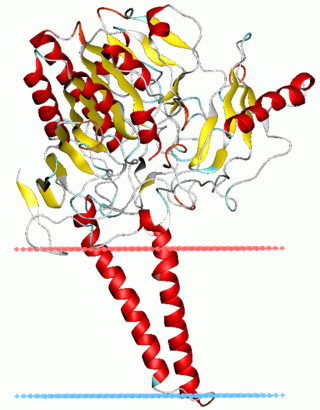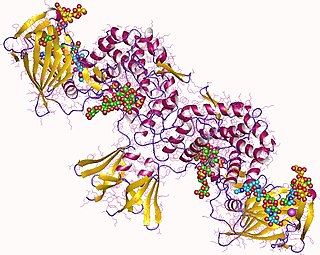
Teicoplanin is an antibiotic used in the prophylaxis and treatment of serious infections caused by Gram-positive bacteria, including methicillin-resistant Staphylococcus aureus and Enterococcus faecalis. It is a semisynthetic glycopeptide antibiotic with a spectrum of activity similar to vancomycin. Its mechanism of action is to inhibit bacterial cell wall synthesis.

Sulfatases EC 3.1.6.- are enzymes of the esterase class that catalyze the hydrolysis of sulfate esters. These may be found on a range of substrates, including steroids, carbohydrates and proteins. Sulfate esters may be formed from various alcohols and amines. In the latter case the resultant N-sulfates can also be termed sulfamates.

N-acetylglucosamine-6-sulfatase (EC 3.1.6.14, glucosamine (N-acetyl)-6-sulfatase, systematic name N-acetyl-D-glucosamine-6-sulfate 6-sulfohydrolase) is an enzyme that in humans is encoded by the GNS gene. It is deficient in Sanfilippo Syndrome type IIId. It catalyses the hydrolysis of the 6-sulfate groups of the N-acetyl-D-glucosamine 6-sulfate units of heparan sulfate and keratan sulfate

Heparosan-N-sulfate-glucuronate 5-epimerase is an enzyme with systematic name poly( -beta-D-glucuronosyl- -N-sulfo-alpha-D-glucosaminyl) glucurono-5-epimerase. This enzyme catalyses the following chemical reaction

In enzymology, a N-sulfoglucosamine sulfohydrolase (EC 3.10.1.1), otherwise known as SGSH, is an enzyme that catalyzes the chemical reaction
The enzyme chondroitin AC lyase catalyzes the chemical reaction
The enzyme chondroitin B lyase catalyzes the following process:
The enzyme hyaluronate lyase catalyzes the chemical reaction
The enzyme disulfoglucosamine-6-sulfatase (EC 3.1.6.1) catalyzes the reaction
For beta-glucuronidase, see Beta-glucuronidase
In enzymology, a glycyrrhizinate β-glucuronidase (EC 3.2.1.128) is an enzyme that catalyzes the chemical reaction
In enzymology, a N-acetylgalactosaminyl-proteoglycan 3-beta-glucuronosyltransferase is an enzyme that catalyzes the chemical reaction
In enzymology, a N-acetylglucosaminyl-proteoglycan 4-beta-glucuronosyltransferase is an enzyme that catalyzes the chemical reaction
N-acetylglucosaminyldiphosphodolichol N-acetylglucosaminyltransferase is an enzyme with systematic name UDP-N-acetyl-D-glucosamine:N-acetyl-D-glucosaminyl-diphosphodolichol N-acetyl-D-glucosaminyltransferase. This enzyme catalyses the following chemical reaction
Glucuronyl-galactosyl-proteoglycan 4-alpha-N-acetylglucosaminyltransferase is an enzyme with systematic name UDP-N-acetyl-D-glucosamine:beta-D-glucuronosyl-(1->3)-beta-D-galactosyl-(1->3)-beta-D-galactosyl-(1->4)-beta-D-xylosyl-proteoglycan 4IV-alpha-N-acetyl-D-glucosaminyltransferase. This enzyme catalyses the following chemical reaction
Glucuronosyl-N-acetylglucosaminyl-proteoglycan 4-alpha-N-acetylglucosaminyltransferase is an enzyme with systematic name UDP-N-acetyl-D-glucosamine:beta-D-glucuronosyl-(1->4)-N-acetyl-alpha-D-glucosaminyl-proteoglycan 4-alpha-N-acetylglucosaminyltransferase. This enzyme catalyses the following chemical reaction
Hyaluronoglucuronidase is an enzyme with systematic name hyaluronate 3-glycanohydrolase. This enzyme catalyses the following chemical reaction
Xylan alpha-1,2-glucuronosidase is an enzyme with systematic name xylan 2-alpha-D-(4-O-methyl)glucuronohydrolase. This enzyme catalyses the following chemical reaction
UDP-N-acetylglucosamine 4,6-dehydratase (configuration-inverting) (EC 4.2.1.115, FlaA1, UDP-N-acetylglucosamine 5-inverting 4,6-dehydratase, PseB, UDP-N-acetylglucosamine hydro-lyase (inverting, UDP-2-acetamido-2,6-dideoxy-β-L)arabino-hex-4-ulose-forming)) is an enzyme with systematic name UDP-N-acetyl-α-D-glucosamine hydro-lyase (inverting; UDP-2-acetamido-2,6-dideoxy-β-L-arabino-hex-4-ulose-forming). This enzyme catalyses the following chemical reaction
N-acetyl-β-d-glucosaminidase(EC 3.2.1.30; EC 3.2.1.52) is a mesophilic hydrolase that specifically hydrolyzes N-acetyl-glucosides. The enzyme is found across a wide variety of marine and terrestrial creatures with the primary function of breaking down oligosaccharides in the presence of water. One of the primary functions of the enzyme is to target and hydrolyze oligosaccharides containing chitin. In this chitinase function, the enzyme contributes to the ability of many organisms to break down chitin-containing molecules and subsequently digest or re-uptake environmental chitin, carbon, or nitrogen. The enzyme's crystal structure varies slightly across organisms, but is characterized by three or four domains with one active site. Across proteins, the active site entails an α-β barrel with either an arginine or tryptophan residues in the barrel pocket to bind incoming substrate.





